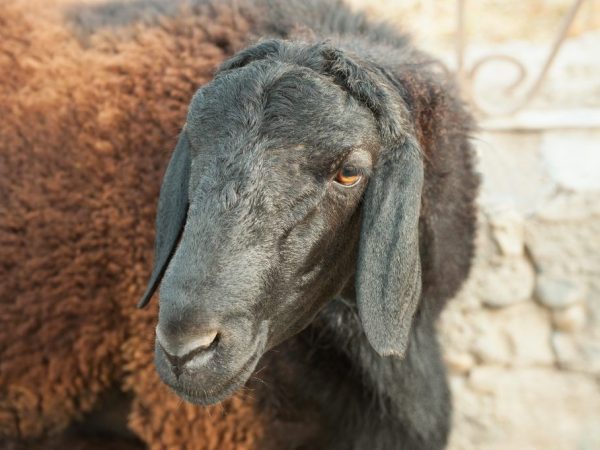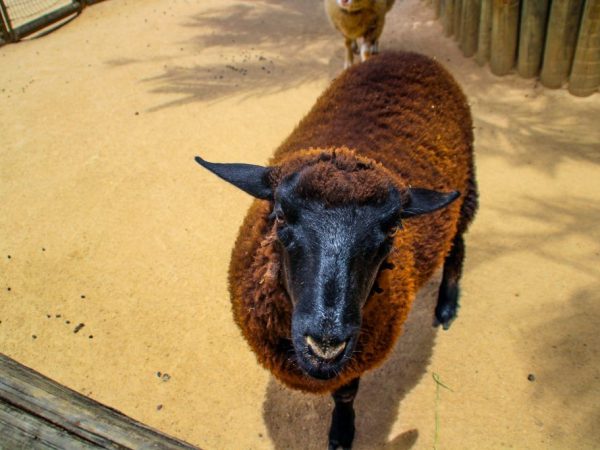Hissar rams and sheep
Hissar rams are on the list of the largest representatives capable of gaining weight up to 190 kg. Their good health and adaptability to mountain climatic conditions are the main advantages for sheep breeding on an industrial and private scale.

Characteristics of sheep and rams of the Hissar breed
About Hissar sheep
The Gissar breed of sheep came to us from Tajikistan, where it was bred by local breeders from crossed rams. Some sheep breeders believe that the Gissars carry the genes of the Edilbaev breed.
Among this breed, animals can be raised in one of 3 main directions, due to reproduction between different species:
- meat-feeding sheep lines, most often bred in Russia,
- individuals of the greasy breeding direction,
- coarse wool sheep for meat.
The name of the breed is directly related to the place of their appearance - the Gissar mountain range. The sheep of the Hissar breed raised in mountain climatic conditions are able to easily endure hot seasons with the scorching sun and cold winters with frost. Such natural vitality and endurance allowed the breed to come to the fore in the Central Asian countries and spread for breeding in the desert steppes of western Uzbekistan.
Despite the low price of sheep and ewes, the pedigree line did not become widespread in Russia, and did not displace the widespread varieties of lambs from the meat directions of domestic sheep breeding.
Exterior characteristics
According to the description of the individuals of the described breed, it cannot be attributed to externally attractive animals. They have a disproportionately folded body, and a small head and slender limbs do not fit into the overall dimensions of a massive body.
The descriptive characteristics of sheep include a set of characteristic exterior signs that make it possible to recognize these animals in photos and videos:
- the body is elongated,
- the body is well developed, with a strong constitution and a raised massive fat tail in the region of the sacrum,
- small head and short neck,
- thin and rather long limbs,
- protruding chest
- hornlessness,
- the presence of a hump in the nose,
- ears are long enough, hanging,
- short, no more than 9 cm, tail.

The appearance of sheep and rams of the Hissar breed
The height of the Gissar breed of sheep grows to 0.8 m. The ram at the withers is about 85 cm. The impressive body volumes are provided due to the large weight:
- the weight of an adult Hissar ram - up to 0.12 tons,
- Hissar sheep weigh 90 kg.
Some specimens of the breed line are capable of weighing up to 0.19 tonnes of live weight. At the same time, the fat tail sack of the Gissar sheep makes up about a third of the total weight of animals and gains up to 25-40 kg of weight.
The color of a sheep's rune depends on the geography of its habitat. According to the color of the wool, the Hissar breed of sheep is found red with black, white with red or brown shades.
Productive achievements
Productivity indicators directly depend on the direction of breeding. Hissar sheep, raised to obtain meat from them, are distinguished by a rather poorly developed fat-tailed part, while the greasy and meat-sucking directions of bred animals have weighty fat tail, which act as a source of fatty components and water for them, allowing them to spend the accumulated reserves in the absence of the necessary amount of pasture. Lamb fat, in addition to the fat tail, is also deposited in the internal organs and under the skin.
The Hissars have woolen hair rather coarse and short in length. It contains an admixture of awn with dead hair, so their fleece is not taken as a material for the manufacture of expensive fur coat products, but most often goes to the production of felt.
The Gissar breed of sheep is often chosen for home breeding because of its high productive performance. The slaughter yield of sheep carcasses is about 60%, and the early maturity and intensive growth of lambs allows you to get meat from individuals that have reached only 3-4 months of age.
Young meat has the best quality characteristics and carries many nutritional properties that are beneficial to the human body.
Despite the low fertile ability of ewes (no more than 120 percent), up to 120 liters of milk can be obtained from this breed annually, provided that the born lambs are transferred to artificial feeding in a timely manner.
Although sheep wool is not considered an expensive material for sewing fur coats, from one individual for 2 haircuts a year you can get from 2 to 3 kg of wool fleece.
Differences in content
There is no need to create special conditions for keeping sheep for home breeding. At the onset of the cold season, animals are driven to mountainous areas, where, in the absence of snow cover, they seek food for themselves. Summer grazing on natural pastures can significantly save finances on the maintenance and nutrition of sheep.
Weather changes are not terrible for the Gissars. Their coarse wool cover protects animals from cold weather and hot sun.
For the wintering of hardy sheep, ordinary, without additional heating, self-built shepherd dogs, or even sheds that allow shelter from the winds, are quite suitable.
Nomadic by nature ewes and rams of Hissar need regular grazing in the wild, allowing them to move without restrictions during the daylight hours. Therefore, if it is impossible to provide free pasture range for this breed line, it is not recommended to start them.
Feed subtleties
Those who are accustomed to getting their own food, even in the conditions of the sparse vegetation areas of Gissar, do not require a variety in the diet and may well be content with the poverty of natural pastures. Sheep and rams of the Hissar breed in a timely manner throughout the warm summer-autumn period, make reserves of nutrients for themselves, accumulating them in the fat-tailed part, actively using succulent grasses and shoots of trees and shrubs.
Provided that the Gissars are predominantly kept in the limited space of the corrals, they are provided with fresh grass and round-the-clock access to clean water.
The ration of feeding gissars, like other sheep breeds, in the winter season consists of hay, cereals and root crops, diluted with food waste and enriched with vitamin supplements.
Breeding rules
The low fertility of ewes does not allow to bring large offspring at one time, since in this breed branch, multiplicity is extremely rare. However, the excellent survival rate of young animals in almost 100% of cases makes it possible to raise the offspring to their feet.
Free mating of rams and sheep of the Hissar breed bring results throughout the entire calendar year.Pregnancy of ewes lasts about 145 days, and during this time the animals are in open pastures until the offspring appear.
In conditions of free coverings, each Gissar ram is capable of covering up to 15 ewes.
Intensively developing newborn lambs gain weight rapidly. Lambs become fully independent at the age of 3 months, earning their own food. From this age until reaching 5 months, young lambs can be slaughtered for tasty meat or left as breeding material.


